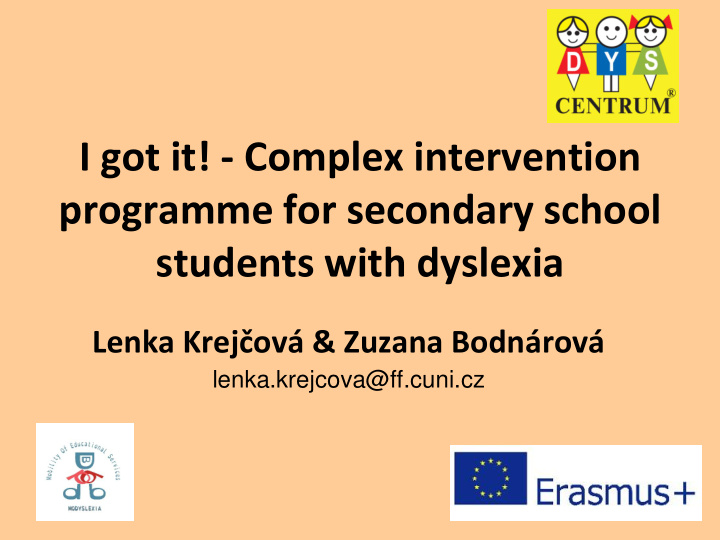



I got it! - Complex intervention programme for secondary school students with dyslexia Lenka Krejčová & Zuzana Bodnárová lenka.krejcova@ff.cuni.cz
„I got it!“ - programme of learning strategies development » based on one‘s strengths to enhance one‘s weaknesses » 12 lessons (2 – 3 tasks in each lesson) » main focus on reading and writing skills based on work with scientific texts » individual or group work (max. 3 students) » individually adapted to particular needs of a student
Main theoretical background dyslexia theories mediated learning experience theory conceptual learning theory implicit and explicit information processing and implicit and explicit learning cognitive styles and learning preferences
Reading skills and strategies » vocabulary development » training of decoding and comprehension strategies (e.g. a use of SQ3R strategy) » each text in each lesson bears specific tasks (e.g. structuring text, use of titles and subtitles, transformation of texts into other forms, searching key words) » further training of use of tables, charts, mind maps etc.
SQ3R survey question read respond review
Reading skills and strategies - what helps syllables rhyming, blending, segmenting, manipulation, deletion structure of text Pra gue is the ca pi tal of the Czech Re pub lic. practice of complicated and unusual words before reading the whole text use of dictionaries creation of vocabulary
Other areas of the programme verbal skills planning and work organization social skills spatial orientation memory
Evaluation of the programme • subjects: 20 adolescent - secondary school students (aged 15- 18) • methodology: qualitative (action research) + reading comprehension test, dyslexia questionnaire, academic self- concept and efficacy questionnaire (MALS) • procedure: assessment ✒ programme (approx. half a year) ✒ re-assessment + analysis of field data
Outcomes • The subjects learned how to skim, scan, and analyze texts of different qualities (e.g. historical essays, journal articles, technical texts). • They learned how to use key words in texts, how to write notes, organize texts into paragraphs, find crucial parts of a text, summarize what they have read/learned. • They learned how to write a biography, how to create a mind map, how to create and interpret charts and tables. • They started thinking about their learning preferences.
Outcomes – cont. • They learned productive learning strategies (e.g. planning and controlling tasks, thinking about their metacognitive processes, prioritizing their work). • Their verbal abilities have widened (all through the programme they were encouraged to verbalize their activities, to describe their working strategies, and to give complete sentences when answering). • They started using the learned strategies at school.
Outcomes – cont. “This text was much easier that the previous one as I could find many clues in it; and it helped me to complete “I don’t have to go to school all the tasks. ” any more. I’ve learned all I (a comment of one of the students – in fact the need to know during the text was more complicated – yet, he managed it without any mistake!) programme.” (another comment from a student)
References • Bartlett, D., & Moody, S. (2000). Dyslexia in the Workplace . London, Philadelphia: Whurr. • Blakemore, S. – J., & Frith, U. (2005). The Learning Brain: lessons for education. Malden, Oxford, Carlton: Blackwell Publishing. • Feuerstein, R. et al. (2010). Beyond smarter: mediated learning and the brain’s capacity for change. New York: Teachers’ College Press. • Hargreaves, S. (Ed.). (2007). Study Skills for Dyslexic Students . London: Sage Publications. • Hunter Carsch, M., & Herrington, M. (2005). Dyslexia and Effective Learning in Secondary and Tertiary Education . London, Philadephia: Whurr. • Kozulin, A. (1998) Psychological tools: A Sociocultural Approach to Education . London: Harvard University Press. • Mentis, M. T.,Dunn-Bernstein M. J., & Mentis, M. (2008). Mediated learning: teaching, tasks, and tools to unlock cognitive potential . Thousand Oaks: Corwin Press. • Moody, S. (2004). Dyslexia: A Teenager’s Guide . London: Vermilion. • Nicolson, R. I., & Fawcett, A. J. (2008). Dyslexia, Learning, and the Brain . Cambridge, London: Massachusetts Institute of Technology. • Sonnesyn, G., & Hem, M. A. (1999). Grunnlaget. Voss: BeMa-forlag. • Sloutsky, V. M. (2010). From Perceptual Categories to Concepts: What Develops? Cognitive Science , vol. 34, p. 1244-1286. • Smythe, I. (2010). Dyslexia in the digital age: making IT work . London, New York: Continuum Books. • Vygotskij, L. S. (2004). Psychologie myšlení a řeči . Praha: Portál. • Zelinková, O. (2009). Poruchy učení: dyslexie, dysgrafie, dysortografie, dyskalkulie, dyspraxie, ADHD . Praha: Portál.
Recommend
More recommend